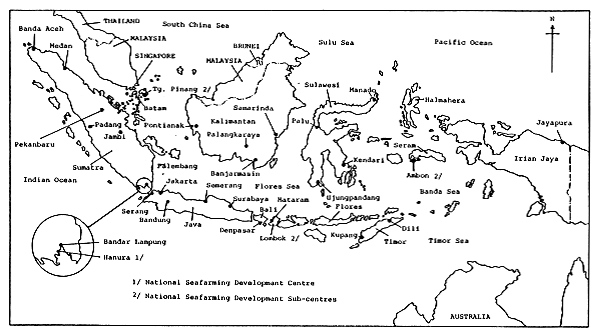For nearly a decade the feeding of cage reared grouper (Plectropomus sp. Epinephelus sp.), snapper (Lutjanus sp.), seabass (Lates calcarifer) and rabbitfish (Siganus sp.) in the Riau Archipelago of Indonesia has been based upon the exclusive use of locally caught marine ‘food fish’, including sardines (Clupea/Dussumieria sp.), jacks (Caranx sp.), pony fish (Leiognathus sp.), scads (Decapterus sp.) and anchovies (Engraulis sp; Tiensongrusmee and Rais, 1989). Whilst there is no doubt of the current economic viability of this feeding practice within a well managed cage farm (Chong, 1989), these marine ‘food fish’ (often incorrectly referred to as ‘trash fish’) constitute a much needed source of inexpensive animal protein for human consumption which is both seasonal in occurrence and finite in quantity. Clearly, if the cage farming sector is to expand into a major national dollar earning seafarming activity then alternative non ‘food fish’ based cage feeding strategies will also have to be developed.
With this goal in mind ten cage/tank culture trials were conducted with seabass, grouper and rabbitfish at the National Seafarming Development Centre, Lampung (see Figure 1) between 1984 and 1988 (Anon, 1989). The culture trials involved the use of a variety of frozen fish and moist diet formulations; the results of these culture trials are summarized in Appendix 1. Whilst the overall growth response of seabass and grouper fed a frozen fish ration was generally good, the observed food conversion efficiency (food fed/body weight gain) was poor, ranging from 7.6 to 11.2 and 7 to 8.9 for seabass and grouper, respectively. Furthermore, seabass fed moist pelleted rations displayed reduced growth and increased mortality, with food conversion ratios ranging from 15 to 20. By contrast, the average food conversion ratio for these species on commercial cage farms in the Riau Archipelago has been estimated to be 5.3 (Tiensongrusmee and Rais, 1989). However, culture trials with rabbitfish were more encouraging; fish displaying good growth on moist pelleted diets and having food conversion ratios ranging from 4 to 15.6. To a large extent the rather disappointing results observed with seabass and grouper were due to over feeding and poor feed management techniques.
It must be emphasized that the success of a dietary feeding regime depends on five main factors, namely;
The nutritional characteristics of the diet or food item fed (ie. ingredient selection, nutrient level, and digestibility).
The manufacturing process used to produce the formulated ration and the physical characteristics of the resultant diet (ie. cutting, cold pelleting, steam pelleting, grinding, air drying, freeze drying, sun drying, feed size, shape, colour, texture, buoyancy and water stability).
The handling and storage of the diet prior to feeding (ie. length of storage and storage conditions).
The feeding method employed (ie. hand or mechanized feeding, feeding frequency, feeding rate - demand or fixed schedule).
The environmental conditions of the culture system (ie. water quality, water circulation, natural productivity and photoperiod).
Clearly, any attempt to compare different dietary feeding regimes must pay special attention to each of the above mentioned factors; the negligence of one factor reducing the effectiveness of the others and eventually resulting in sub-optimal feed performance and growth (Tacon, 1988).
This report is based on the INS/81/008 cage feeding trials conducted with seabass, grouper and rabbitfish at the National Seafarming Development Centre in Teluk Hurun between 7 December 1988 and 31 December 1989. During these feeding trials particular emphasis was placed on the use and evaluation of local (ie. Indonesian) feed ingredient sources and animal feed lines available in the market place.

Figure 1 . Map of Indonesia and location of major cities and National Seafarming Development centre and Sub-centres